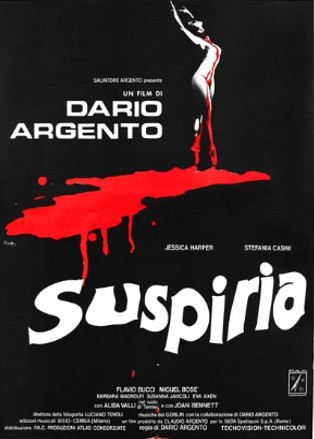
One of the greatest tragedies that can fall on a film is being forgotten in the shadow of a remake or a reinterpretation with a greater relevance in popular culture. Such a phenomenon happens equally with both great films and terrible films, such as John Carpenter’s The Thing (1982) or Rupert Wainwright’s The Fog (2005) – both of which are remakes which have overshadowed their predecessors in mainstream consciousness. Such a fate may soon fall on Dario Argento’s unnerving and influential horror film, Suspiria (1977). With a remake slated for release this year, and a screening of the recently discovered uncut version of the film coming to the Coral Gables Art Cinema, now’s a better time than ever to examine why this film from the creator of 1978’s Dawn of the Dead has developed its persistent cult following.
Argento’s Susperia focuses on American ballet student Suzy Bannion (Jessica Harper) who arrives at the prestigious Tanz Dance Academy in Germany to further her studies. However, during her time in this school, an unnerving presence and a series of murders force her to reevaluate exactly what she thinks she knows about her new environment. The film’s style as a whole is utterly fantastic, and feels like watching a nightmare in all the right ways. The sets are beautifully exaggerated, with bright colors that pop in nearly every frame of the film. The Tanz Dance Academy feels as if it was plucked right out of Edgar Allen Poe’s “The Masque of Red Death”, and is as foreboding as it is pleasant to look at.
The lighting is just as colorful as the sets, making the film’s palette all the more dynamic and unearthly. When the sun sets and the darkness surrounds our characters, these vivid Technicolor lighting choices accentuate the film’s tense and scary moments, drenching the screen in beautiful shades of ghoulish greens, rich reds, deep blues, and ancient yellows. Nearly every shot of the film is phenomenally composed, with many shots near the film’s climax looking like they were destined for a movie adaptation of a fairy tale rather than a horror film, a contrast that works wonderfully considering the film’s supernatural elements.
The score is filled with psychedelic melodies that leaves your core absolutely unnerved. Goblin, the band responsible for the soundtrack, make the score live up to the film’s name, as Suspiria is Latin for ‘sighs’, by filling the music with otherworldly moans and ghastly wails. The music is a memorable cacophony pulled straight from your strangest night terror.
Although the film as a whole is artistically dazzling, there are aspects of Suspiria that haven’t held up very well. The acting can feel unnatural at times, though this may be written off as part of the film’s overall vibe of a Technicolor fever dream. Additionally, a good chunk of the special effects used for the violence and gore in this picture were clearly a product of the time, and aren’t very convincing nearly forty one years after the film’s initial release. For example, in the last third of the film Suzy gets attacked by a bat, which to me looked more like a cuddly wind-up toy than a vicious creature of the night. Not every sequence is as terribly unconvincing as the bat scene, but the quality is noticeable enough that keeping the film’s age in mind may help dull the inevitable eye-rolls during such moments, especially since the film is surprisingly light on such violence. Other than these objective flaws, the film ended a bit more abruptly than I had expected, though I’ll sooner take a sudden credit scroll over a clichéd “the evil isn’t really defeated” type of ending you might find in horror movies like A Nightmare on Elm Street (1984) or Friday the 13th (1980).
Though elements of Suspiria show their age, the overall experience present in this absolutely odd fever dream is unique, and worth looking into for the casual moviegoer. However, if you consider yourself a fan of the horror genre, this is an absolute must-watch. The stylistic choices made for this film help amplify the utterly creepy atmosphere, and elevate this film in my mind as memorable among the blended slog of dark and grimy movies of recent years. Though the future legacy of Suspiria hangs in the air, the classic still remains, and now is a better time than any to let yourself sink into this cult classic.
Coral Gables Art Cinema will be screening the recently discovered uncut version of Suspiria on Friday, February 2nd at 11:30 pm. Tickets are available here.

 George Ibarra is a Senior at Florida International University, pursuing a Bachelor’s Degree in English with a minor in Sociology, along with Certificates in Exile Studies and Film Studies.
George Ibarra is a Senior at Florida International University, pursuing a Bachelor’s Degree in English with a minor in Sociology, along with Certificates in Exile Studies and Film Studies.
